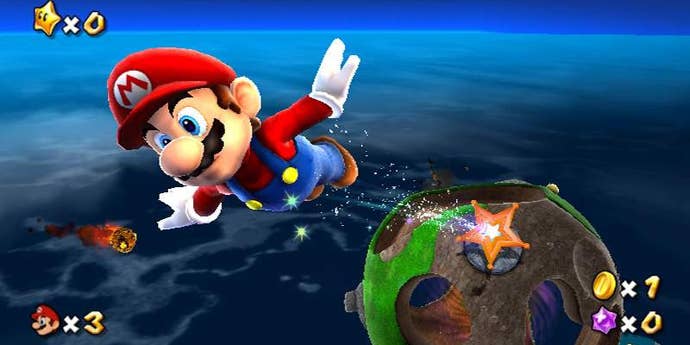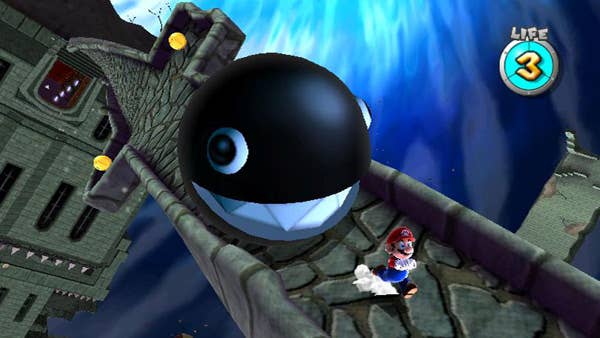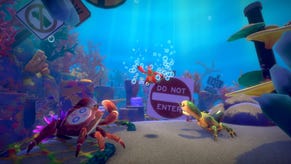The 15 Best Games Since 2000: The Complete List
What are the fifteen best games from the past fifteen years? Here's our complete list.
This article first appeared on USgamer, a partner publication of VG247. Some content, such as this article, has been migrated to VG247 for posterity after USgamer's closure - but it has not been edited or further vetted by the VG247 team.

#11: Super Mario Galaxy
Super Mario 64 might not have been the first platformer set in a 3D environment, but it was the first creation to show the world how this style of game should be done. (Sorry, Bubsy.)
And that was Nintendo's trajectory up until the GameCube era. Just as the original Super Mario Bros. and The Legend of Zelda established the rules of their respective genres, their polygonal, N64 installments did the same for a new generation of technology. But this sense of innovation stalled a bit when it came time for Nintendo to follow-up Mario's groundbreaking N64 launch game. 2002's Super Mario Sunshine isn't a bad game, per se, but the typically innovative Nintendo fell back on current trends instead of forging their own path.
Using the then-novel open-world game as a jumping-off point, Sunshine is essentially Super Mario 64, but bigger, featuring sprawling worlds stuffed with collectables that would find themselves at home in any contemporary Rare game. (Anyone who's attempted to track down all of those insufferably hidden blue coins can attest to this.) While Mario's new water-spewing backpack acted as a helpful crutch in dealing with precarious platforming in these massive environments, a bigger Super Mario 64 wasn't necessarily a better Super Mario 64. So back to the drawing board they went.
"... Super Mario Galaxy boldly went where no platformer had gone before with its take on gravity."
Just as Super Mario 64 followed up on the original Super Mario Bros. eleven years later, there's a strange sense of symmetry with how Mario's first 3D platformer saw its true follow-up in the same amount of time. Super Mario Galaxy shook off its predecessor's open-world leanings for a much more focused experience that split its fairly large levels into short, distinct challenges. And while it didn't reinvent the wheel as much as Mario 64 did back in 1996, Nintendo deserves credit for (mostly) avoiding the siren song of motion control just one year after Wii Sports lit the world—and most living rooms—on fire. Instead of going whole hog with the Wiimote's capabilities, Galaxy uses the features of this controller in some pretty natural ways: A satisfying flick of the wrist is all it takes for Mario to perform one of several contextual actions, and it only takes a few levels for this action to feel as second-nature as pushing a button.
Galaxy also borrows the same power-up philosophy as Super Mario 64, but its selection of Mario-changing items manages to be much more interesting. And these power-ups aren't necessarily empowering, either. Some of them last for a limited amount of time, and focus Mario's talents to a singular ability for the sake of making it to the end of an obstacle course designed with a specific power-up in mind. The result of this approach is a hell of a lot of variety, served up in bite-size slices that go down easy. While Super Mario Sunshine usually tasked players from finding their way from point A to point B via extensive, precarious platforming with no safety net, brevity stands as Super Mario Galaxy's greatest strength. It's still a fairly meaty game, mind you, but few challenges outstay their welcome, or force you to retrace too many steps upon failure.
In terms of innovation, Super Mario Galaxy boldly went where no platformer had gone before with its take on gravity. Thanks to the laws of Mario Science, most floating bodies in Galaxy—regardless of their size—possess their own gravitational pull, meaning that if Mario jumps high enough towards a floating planetoid above him, he'll flip, fall upwards, and stick to this newfound terra firma in an instant. This effect may sound pretty simple, but it's nothing short of a programming miracle that the constantly changing gravity of Galaxy's world actually functions so sublimely. By the time some of the more difficult levels roll around, you'll be jumping from meteorite to meteorite in the void of deep space as effortlessly as you would in the relatively safer Mushroom Kingdom.
If anything is a testament to the greatness of Super Mario Galaxy, it's the fact that Nintendo created a direct sequel a few years later—something they haven't done with the brand since 1986's Super Mario Bros. 2 (known to us Americans as "The Lost Levels"). Clearly, Nintendo EAD loved the formula they created so much, they simply didn't want to let it go before the Wii sailed off into console Valhalla. And though Mario's gone on to do other things since his Wii-exclusive series ended half a decade ago, those of us who fell in love with 3D platforming all over again after Galaxy are still waiting for the next evolution. With any luck, it won't take another 11 years. - Bob Mackey


.jpg?width=291&height=164&fit=crop&quality=80&format=jpg&auto=webp)





